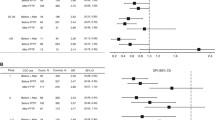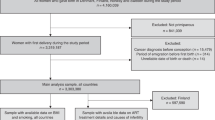Abstract
Purpose
Incessant ovulation has been consistently linked to epithelial ovarian cancer (EOC). Although reproductive characteristics differ substantially by race, the association between incessant ovulation and EOC has been evaluated only in populations of predominantly white women. In the present study, we examined the association between lifetime number of ovulatory cycles (LOCs) and EOC risk among African American (AA) women.
Methods
We used data from 534 cases and 722 controls enrolled in the African American Cancer Epidemiology Study. LOCs were determined using the standard method, with modifications to include episodes of irregular or missed periods. Multivariable logistic regression was used to estimate odds ratios (ORs) and 95% confidence intervals (CIs) for the association between LOCs and EOC risk overall and by age, while adjusting for appropriate confounders.
Results
The mean number of LOCs was 378.2 ± 105.8 for cases and 346.4 ± 117.3 for controls. Women in the highest tertile of LOCs had 59% higher odds of EOC compared to women in the lowest tertile (OR = 1.59; 95% CI = 1.15–2.20). When examining this relationship by age, the positive association with EOC was stronger among women <50 years of age (OR for highest vs. lowest tertile = 2.61; 95% CI = 1.15–5.94), followed by women aged 50–60 years (OR = 2.27; 95% CI = 1.30–3.94). Yet, no association was present among women aged >60 years (OR = 0.79; 95% CI = 0.45–1.40).
Conclusions
In a population of AA women, we observed a positive association between LOCs and EOC risk, providing further support for the hypothesis that incessant ovulation contributes to the etiology of EOC.
Similar content being viewed by others
References
Fathalla MF (1971) Incessant ovulation—a factor in ovarian neoplasia? The Lancet 2:163
Fathalla MF (2013) Incessant ovulation and ovarian cancer—a hypothesis re-visited. Facts Views Vis ObGyn 5:292–297
Fleming JS, Beaugie CR, Haviv I et al (2006) Incessant ovulation, inflammation and epithelial ovarian carcinogenesis: revisiting old hypotheses. Mol Cell Endocrinol 247:4–21
Cramer DW, Welch WR (1983) Determinants of ovarian cancer risk. II. Inferences regarding pathogenesis. J Natl Cancer Inst 71:717–721
Risch HA (1998) Hormonal etiology of epithelial ovarian cancer, with a hypothesis concerning the role of androgens and progesterone. J Natl Cancer Inst 90:1774–1786
Hanahan D, Weinberg RA (2011) Hallmarks of cancer: the next generation. Cell 144:646–674
Ness RB, Cottreau C (1999) Possible role of ovarian epithelial inflammation in ovarian cancer. J Natl Cancer Inst 91:1459–1467
Tung K-H, Goodman MT, Wu AH et al (2003) Reproductive factors and epithelial ovarian cancer risk by histologic type: a multiethnic case–control study. Am J Epidemiol 158:629–638
Schildkraut JM, Bastos E, Berchuck A (1997) Relationship between lifetime ovulatory cycles and overexpression of mutant p53 in epithelial ovarian cancer. J Natl Cancer Inst 89:932–938
Terry KL, Titus-Ernstoff L, McKolanis JR et al (2007) Incessant ovulation, mucin 1 immunity, and risk for ovarian cancer. Cancer Epidemiol Biomarkers Prev 16:30–35
Moorman PG, Schildkraut JM, Calingaert B et al (2002) Ovulation and ovarian cancer: a comparison of two methods for calculating lifetime ovulatory cycles (United States). Cancer Causes Control 13:807–811
Purdie DM, Bain CJ, Siskind V et al (2003) Ovulation and risk of epithelial ovarian cancer. Int J Cancer 104:228–232
Webb PM, Green A, Cummings MC et al (1998) Relationship between number of ovulatory cycles and accumulation of mutant p53 in epithelial ovarian cancer. J Natl Cancer Inst 90:1729–1734
Gwinn ML, Lee NC, Rhodes PH et al (1990) Pregnancy, breastfeeding, and oral contraceptives and the risk of epithelial ovarian cancer. J Clin Epidemiol 43:559–568
Titus-Ernstoff L, Perez K, Cramer DW et al (2001) Menstrual and reproductive factors in relation to ovarian cancer risk. Br J Cancer 84:714–721
Luan N, Wu Q, Gong T et al (2013) Breastfeeding and ovarian cancer risk†¯: a meta-analysis of epidemiologic studies. Am J Clin Nutr 98:1020–1031
Whittmore AS, Harris R, Itnyre J, Group COC (1992) Characteristics relating to ovarian cancer risk: collaborative analysis of 12 US case–control studies. II. Invasive epithelial ovarian cancers in white women. Am J Epidemiol 136:1184–1203
Siskind V, Green A, Bain C, Purdie D (2000) Beyond ovulation: oral contraceptives and epithelial ovarian cancer. Epidemiology 11:106–110
Moorman PG, Palmieri RT, Akushevich L et al (2009) Ovarian cancer risk factors in African-American and white women. Am J Epidemiol 170:598–606
Chumlea WC, Schubert CM, Roche AF et al (2003) Age at menarche and racial comparisons in US girls. Pediatrics 111:110–113
Schildkraut JM, Alberg AJ, Bandera EV et al (2014) A multi-center population-based case–control study of ovarian cancer in African-American women: the African American Cancer Epidemiology Study (AACES). BMC Cancer 14:688 doi:10.1186/1471-2407-14-688
Schildkraut J, Abbott S, Alberg A, et al (2016) Association between body powder use and ovarian cancer: the African American Cancer Epidemiology Study (AACES). Cancer Epidemiol Biomarkers Prev 25:1411–1417
Peres LC, Camacho F, Abbott SE et al (2016) Analgesic medication use and risk of epithelial ovarian cancer in African American women. Br J Cancer 114:819–825
Tung KH, Wilkens LR, Wu AH et al (2005) Effect of anovulation factors on pre- and postmenopausal ovarian cancer risk: revisiting the incessant ovulation hypothesis. Am J Epidemiol 161:321–329
Negri E, Franceschi S, Tzonou A et al (1991) Pooled analysis of 3 European case–control studies: I. Reproductive factors and risk of epithelial ovarian cancer. Int J Cancer 49:50–56
Beral V, Doll R, Hermon C et al (2008) Ovarian cancer and oral contraceptives: collaborative reanalysis of data from 45 epidemiological studies including 23,257 women with ovarian cancer and 87,303 controls. Lancet 371:303–314
Rothman KJ (1981) Induction and latent periods. Am J Epidemiol 114:253–259
Burger HG, Dudley EC, Robertson DM, Dennerstein L (2002) Hormonal changes in the menopause transition. Recent Prog Horm Res 57:257–275
Gnagy S, Ming EE, Devesa S et al (2000) Declining ovarian cancer rates in US women in relation to parity and oral contraceptive use. Epidemiology 11:102–105
Shih I-M, Kurman RJ (2004) Ovarian tumorigenesis: a proposed model based on morphological and molecular genetic analysis. Am J Pathol 164:1511–1518
Jukic AMZ, Weinberg CR, Wilcox AJ et al (2008) Accuracy of reporting of menstrual cycle length. Am J Epidemiol 167:25–33
Bosetti C, Tavani A, Negri E et al (2001) Reliability of data on medical conditions, menstrual and reproductive history provided by hospital controls. J Clin Epidemiol 54:902–906
Mihm M, Gangooly S, Muttukrishna S (2011) The normal menstrual cycle in women. Anim Reprod Sci 124:229–236
Yang HP, Murphy KR, Pfeiffer RM et al (2016) Lifetime number of ovulatory cycles and risks of ovarian and endometrial cancer among postmenopausal women. Am J Epidemiol 183:800–814
Acknowledgments
This study was supported by the National Cancer Institute (R01CA142081). Additional support was provided by the Metropolitan Detroit Cancer Surveillance System with funding from the National Cancer Institute, National Institute of Health, and the Department of Health and Human Services (Contract HHSN261201000028C), and the Epidemiology Research Core, supported in part by the National Cancer Institute (P30CA22453) to the Karmanos Cancer Institute, Wayne State University School of Medicine. The New Jersey State Cancer Registry, Cancer Epidemiology Services, New Jersey Department of Health, is funded by the Surveillance, Epidemiology and End Results (SEER) Program of the National Cancer Institute under contract HHSN261201300021I, the National Program of Cancer Registries (NPCR), Centers for Disease Control and Prevention under grant 5U58DP003931-02 as well as the State of New Jersey and the Rutgers Cancer Institute of New Jersey. The authors are grateful for the AACES interviewers, Christine Bard, LaTonda Briggs, Whitney Franz (North Carolina) and Robin Gold (Detroit). We would also like to acknowledge the individuals responsible for facilitating case ascertainment across the ten sites including: Jennifer Burczyk-Brown (Alabama); Rana Bayakly, Vicki Bennett and Judy Andrews (Georgia); the Louisiana Tumor Registry; Lisa Paddock, Natalia Herman and Manisha Narang (New Jersey); Diana Slone, Yingli Wolinsky, Steven Waggoner, Anne Heugel, Nancy Fusco, Kelly Ferguson, Peter Rose, Deb Strater, Taryn Ferber, Donna White, Lynn Borzi, Eric Jenison, Nairmeen Haller, Debbie Thomas, Vivian von Gruenigen, Michele McCarroll, Joyce Neading, John Geisler, Stephanie Smiddy, David Cohn, Michele Vaughan, Luis Vaccarello, Elayna Freese, James Pavelka, Pam Plummer, William Nahhas, Ellen Cato, John Moroney, Mark Wysong, Tonia Combs, Marci Bowling, Brandon Fletcher (Ohio); Susan Bolick, Donna Acosta, Catherine Flanagan (South Carolina); Martin Whiteside (Tennessee) and Georgina Armstrong and the Texas Registry, Cancer Epidemiology and Surveillance Branch, Department of State Health Services.
Author information
Authors and Affiliations
Corresponding author
Ethics declarations
Conflict of interest
The authors declare that they have no conflict of interest.
Rights and permissions
About this article
Cite this article
Peres, L.C., Moorman, P.G., Alberg, A.J. et al. Lifetime number of ovulatory cycles and epithelial ovarian cancer risk in African American women. Cancer Causes Control 28, 405–414 (2017). https://doi.org/10.1007/s10552-017-0853-7
Received:
Accepted:
Published:
Issue Date:
DOI: https://doi.org/10.1007/s10552-017-0853-7




